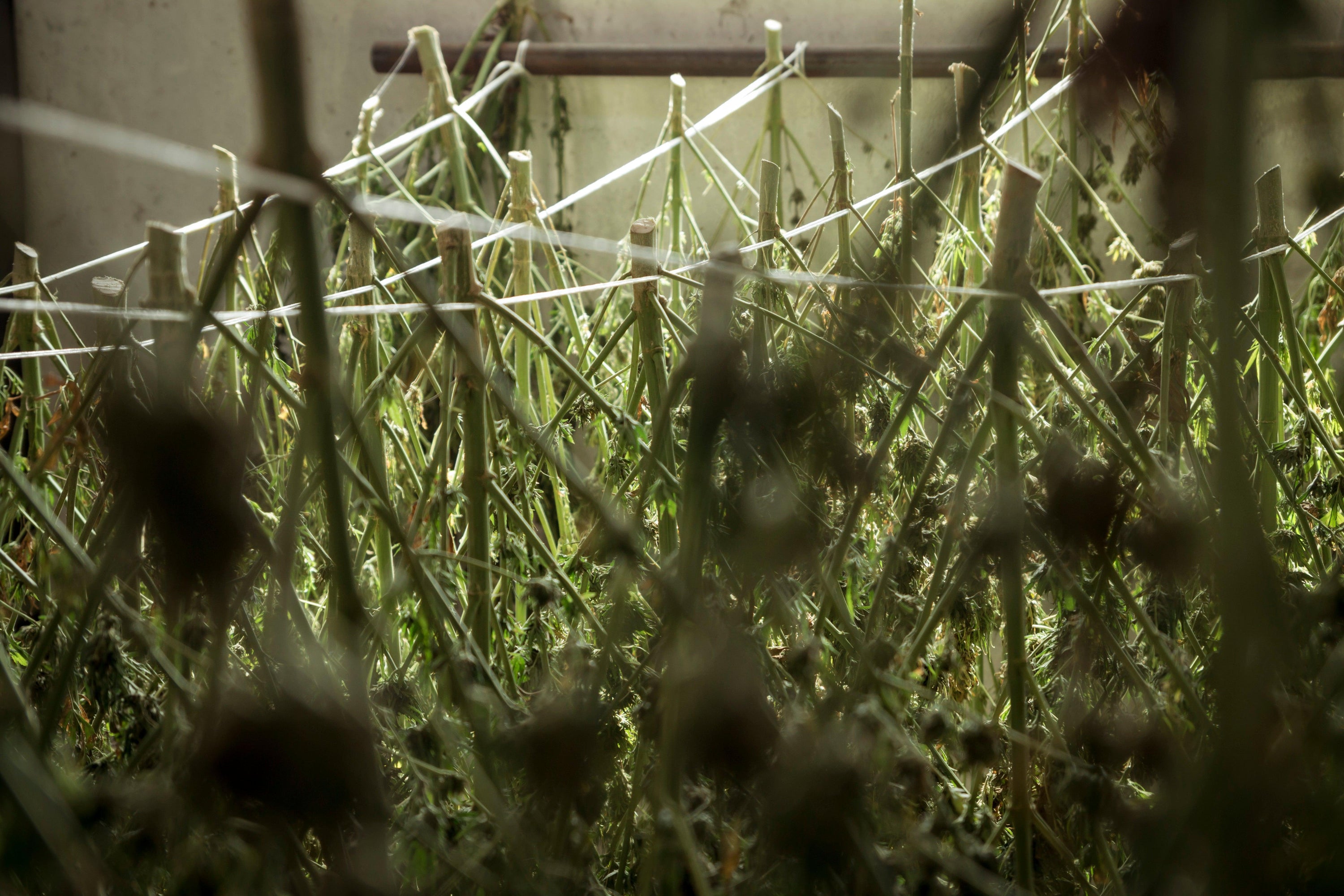What is cannabis drying? How you do it? And tanning? These two processes are fundamental for the success of your cultivation project and certain rules must be followed scrupulously to carry out this job in the best way. Summary:
- How to dry your marijuana buds for the perfect result
- The flowers are ready to be picked: what do I do?
- The drying phase
- The tanning phase
- Glass tanning
- Tanning in water
How to dry your marijuana buds for the perfect result
The flowers are ready to be harvested, the plant is full of inflorescences and the aroma is sour, pungent and persistent. The cultivation phase is finished, but the buds are not yet ready to be used.
Indeed, this is the most delicate moment: fresh buds are very vulnerable , the resin and water they contain can make them mold easily, frustrating the efforts of months and months.
By drying and treating cannabis buds, the flavor and aroma of the inflorescences can be improved, thanks to the process of decomposition of chlorophyll , which - if implemented gradually - makes the taste of dried buds less harsh.
Drying and curing can reduce the risk of developing anxiety after smoking cannabis and can even increase the potency of the cannabinoids.
Additionally, treating your cannabis buds properly can extend their lifespan , so you can enjoy the fruits of your labor for a long time.
The flowers are ready to be picked: what do I do?
The drying phase begins as soon as the plants are pruned. The freshly cut buds - at this stage - are extremely sticky and moist, thanks to the presence of a high quantity of psychoactive resin .
The resin, combined with the water still contained within the fresh flowers, is the perfect medium for the proliferation of bacteria , fungi , and other contaminants. At this stage it is important to act promptly, avoiding leaving the fresh buds in contact with the surrounding environment for a long time.
There are many pruning techniques to cut fresh buds and start the drying phase:
- The wet trimming technique consists of pruning the plants as soon as they reach maturity , cutting the branches one at a time with sharp scissors or shears, so as to eliminate all the surrounding vegetation. The buds are the main focus of this pruning, but the leaves also contain a small amount of cannabinoids and resin and can be stored separately for use in making food and cosmetic products . If the wet trimming technique is used, the fresh buds must be placed on a rather large horizontal surface, which provides the flowers with adequate ventilation. The best option is to place the buds on a wire rack or rack. In this way the air will reach the entire surface of the top.
- The dry trimming technique is used especially when you have little time and many plants to prune. In this procedure it is necessary to cut the branches and hang them entirely to dry . When the plant is dry, you start pruning and treating the buds. Dry trimming is more difficult to do and often less accurate, because the small sugar leaves will be bent towards the flower. Furthermore, with dry trimming you risk losing precious resin. In fact, it can fall from the plant when the branches are handled and hung.
Regardless of the pruning method used, it is essential to carry out the entire procedure inside a drying room. A drying room should be a cool, dark environment , with a temperature of approximately 15-22°C .
The drying phase
The drying process is the phase that decides whether the cannabis you have grown will be of high quality or not: during drying you can lose, preserve, or improve the smell of the buds, and you can refine the flavor and potency of the cannabis .
An incorrect drying process can ruin even the best quality sprouts, undoing months of work. Proper drying takes time and patience, but the quality of the cannabis will reward all the efforts.
The objective of the drying process is to reduce the water contained in the sprouts , which will have to go from 75% to 10-15% , in a recommended time of 10-14 days.
It is important to ensure that the branches do not touch each other, to prevent them from acquiring an unnatural shape during drying. It is optimal to get rid of as much water as possible during the first 3 days of treatment; from here on the process will be downhill.
There are several factors to keep under control to ensure that the drying results are perfect. It is important to keep temperature, humidity, light and air circulation under control .
- Temperature During the first 3 days it would be optimal to keep the plants at a stable temperature of 20 degrees Celsius. This way the sprouts will dry quickly, without drying out excessively. After the first 3 days the temperature should be lowered to around 17-18 degrees Celsius in order to slow down the process.
- Humidity During the first 3 days the relative humidity should be around 50%. After three days the relative humidity should rise to around 60%, again to slow the drying process.
- Air circulation It is very important that there is enough air circulation in the room, which is why it is advisable to use an electric fan. A ventilation device can also come in handy to control temperature and humidity. However, do not point the device directly at the buds, as this could dry the cannabis buds improperly.
- Dark The room should be relatively dark as light, especially direct sunlight, degrades THC.
How to find out if drying is over? There is a very immediate method: you have to try to break the stem ; if this breaks easily it means that the sprouts are dry.
If it curves, it means more time is needed. It is very important not to rush. In this phase, in fact, the chemical structure of the plant changes slightly, and the chlorophyll and other pigments present in the plant tissue evaporate and abandon the shoots.
If the shoots are dried too quickly, some of these pigments will not have time to leave the shoots and will find themselves in the final product, which will have an unpleasant smell and taste.
The tanning phase
Tanning is the phase following the drying process and serves to increase the quality of the buds .
It is a fundamental operation for two reasons:
- It facilitates the degradation of chlorophyll , as it allows the bacteria to have sufficient time to dedicate to this procedure, which significantly improves the quality of the product. Chlorophyll is a green pigment found throughout the plant, and is essential for carrying out photosynthetic functions. Chlorophyll, however, contains magnesium which, when burned, makes the smoke more unpleasant and heavy to taste. When curing a plant, much of this magnesium residue is removed from the plant parts, significantly increasing the overall quality of the experience.
- It allows you to precisely monitor the humidity of the buds . By drying, the water in the bud is eliminated, which makes the cannabis bud stronger and easier to burn. However, overdried bud can lose its best flavors and aromas. The curing process should begin when the buds are dry enough to burn, but still have slight resistance to burning. In this way it is possible to monitor the humidity level until the end of the tanning.
Glass tanning
The most used technique for curing Cannabis involves the use of airtight glass jars , which must be stored in a cool, dry place, away from direct sunlight. The buds need to breathe, so it's important to be careful not to compress them too much inside the jar. The jars must be opened several times a day, in the first week of curing, to move the buds contained inside them and prevent them from pressing or sticking to each other.
After this first week, you can start opening the jars once a day for 30 minutes, repeating the process for about 3-4 weeks.
This should allow for greater control over the levels of moisture retained by the herb, allowing only excess water to escape from the jar. Furthermore, by opening the containers, the bacteria are allowed to receive sufficient oxygen with which to carry out their functions during the chlorophyll degradation process.
The entire tanning process can take from 4 to 8 weeks . The tanning is finished when when the jars are opened there is no more air escaping because the bacteria have stopped degrading the chlorophyll.
Once cured, the buds can be stored for a long time, with the only drawback of seeing the THC concentration drop over time.
Tanning in water
Water tanning is an alternative method to traditional tanning. You need to use the usual glass jars, which must be filled with water. The buds must remain immersed for about a week . This process is more delicate than traditional tanning, but allows you to optimize times.
Many of the substances present in cannabis inflorescences, such as sugars, salts, insecticides and chlorophyll, are soluble in water, therefore the process of synthesizing sugars occurs much more effectively.
What about THC? THC is safe, since cannabinoids are fat-soluble , so they do not dissolve in water. Water only removes chlorophyll residues and other pigments from the buds through osmosis, without reducing the potency of the buds.
If the article was of interest to you, share it on social media with the rest of the Community, every single share helps us support our blog and keep you 360° informed on the world of Cannabis.









